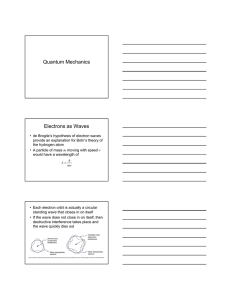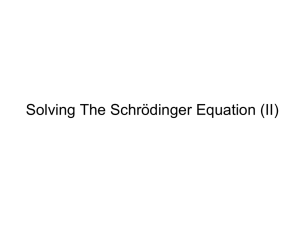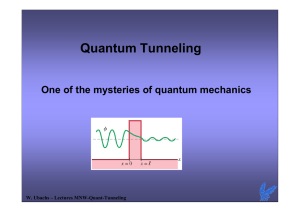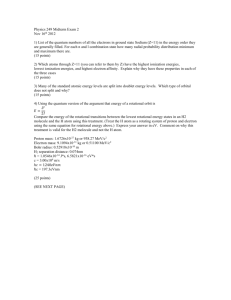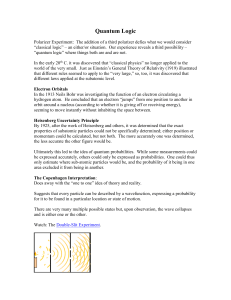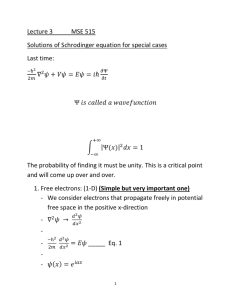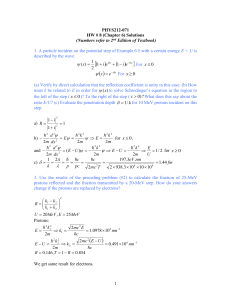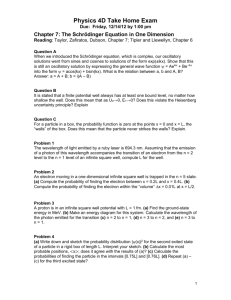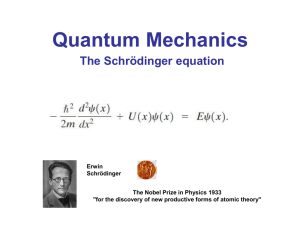Test 1 Modern Physics, Phys 312
advertisement
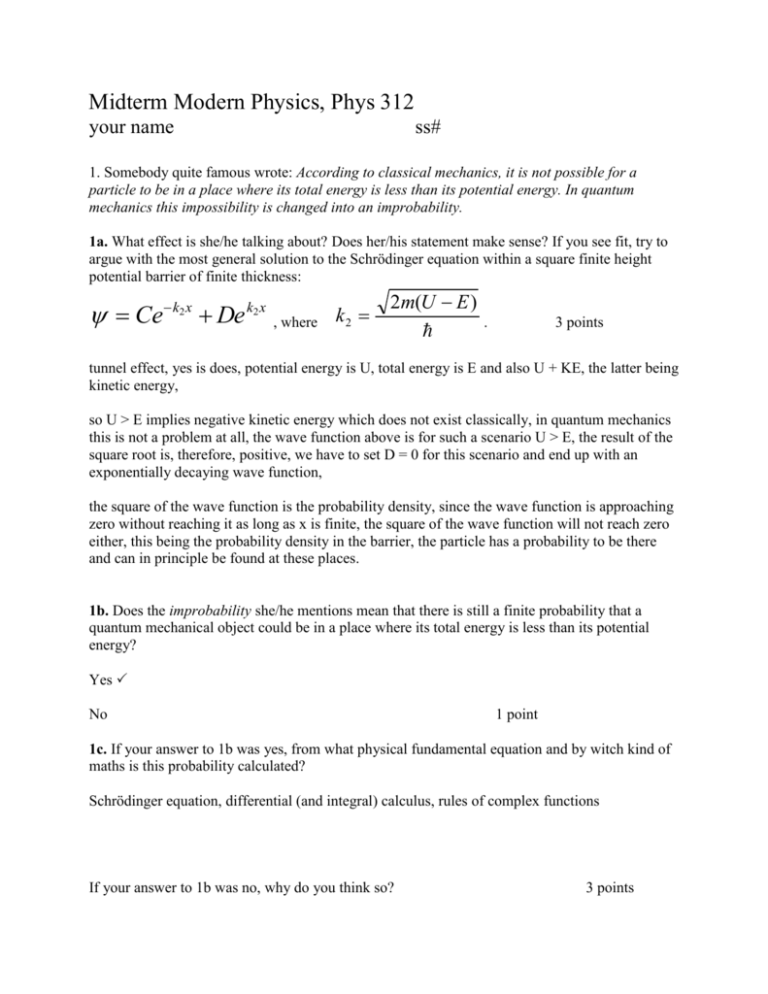
Midterm Modern Physics, Phys 312 your name ss# 1. Somebody quite famous wrote: According to classical mechanics, it is not possible for a particle to be in a place where its total energy is less than its potential energy. In quantum mechanics this impossibility is changed into an improbability. 1a. What effect is she/he talking about? Does her/his statement make sense? If you see fit, try to argue with the most general solution to the Schrödinger equation within a square finite height potential barrier of finite thickness: Ce k x De k x , where 2 2 k2 2m(U E ) . 3 points tunnel effect, yes is does, potential energy is U, total energy is E and also U + KE, the latter being kinetic energy, so U > E implies negative kinetic energy which does not exist classically, in quantum mechanics this is not a problem at all, the wave function above is for such a scenario U > E, the result of the square root is, therefore, positive, we have to set D = 0 for this scenario and end up with an exponentially decaying wave function, the square of the wave function is the probability density, since the wave function is approaching zero without reaching it as long as x is finite, the square of the wave function will not reach zero either, this being the probability density in the barrier, the particle has a probability to be there and can in principle be found at these places. 1b. Does the improbability she/he mentions mean that there is still a finite probability that a quantum mechanical object could be in a place where its total energy is less than its potential energy? Yes No 1 point 1c. If your answer to 1b was yes, from what physical fundamental equation and by witch kind of maths is this probability calculated? Schrödinger equation, differential (and integral) calculus, rules of complex functions If your answer to 1b was no, why do you think so? 3 points 2. Within a hypothetical microelectronic device electrons with a total energy of 10 meV are incident on a square barrier of height 100 meV and widths 0.2 nm. Calculate both the transmission and the reflection coefficients. U = 0.1 eV, E = 0.01 eV, L = 0.2 10-9 m T e 2 k2 L 2 0.4109 e 2 2 m(U KE ) L 29.11031 ( 0.1 0.01)1.6021019 e 6.6251034 as R + T = 1 e 0.6145287 1 e 0.6145287 0.5408958 3 points R = 0.4591042 it is also OK to use the approximation formula from the Serway book, p. 231 in that case, you should obtain T 0.787 and R 0.213 Out of 106 electrons, how many will be transmitted trough this barrier, how many will get stuck for ever in the barrier, and how many will be reflected by the barrier? (Round to full electrons and make pretty accurate calculations above.) approximately 540896 will be transmitted approximately 459104 will be reflected 3 points none will get stuck if you had other values due to the other approximation form the book or just miscalculated, you still get the points (if your calculation is not tooooooooo far off, that is) If the electrons arrive at a rate of 10 per second at the barrier from a time t = t0 onwards, how much time t will have elapsed before the first electron can be detected outside the barrier? the transmission probability being 0.5408958 or 54, …% , 5.4… will tunnel per second and it will take 0.1848785 seconds for the first full electron to emerge 3 points 1electron sec in other words: 1 electron emerges at a time T 10 electrons/second t, so t = T 10electron Why must this time interval t be greater than zero? only a full electron can be detected, neither 10 % of it nor 99%, …, so there must be a finite time greater zero, there is a finite probability density at t 0 as we are talking about a steady state, used the time independent Schrödinger equation, … but a particle can only materialize as a whole particle not a fraction of a particle 2 points 3. Show that the energy level spacing of a harmonic oscillator is in accord with the E n correspondence principle by finding the ratio between adjacent energy levels and seeing En what happens to this ratio as n → Hint: En = (n + 1/2) h f 4 points 4. Calculate the zero-point energy in Joule of a harmonic oscillator with angular frequency 1010 Hz En = (n + 1/2) h f, n = 0 is the lowest quantum number 3 points 10 -1 ω = 2π f = 10 s f = 1.5915 109 s-1 En = 1/2 6.625 10-34 Ws2 1.5915 109 s -1 = 5.272 10-25 J As usual, do not forget to give units with your numerical results, otherwise points will be taken off. Please make life simpler for Conrado and me by boxing your final results.
